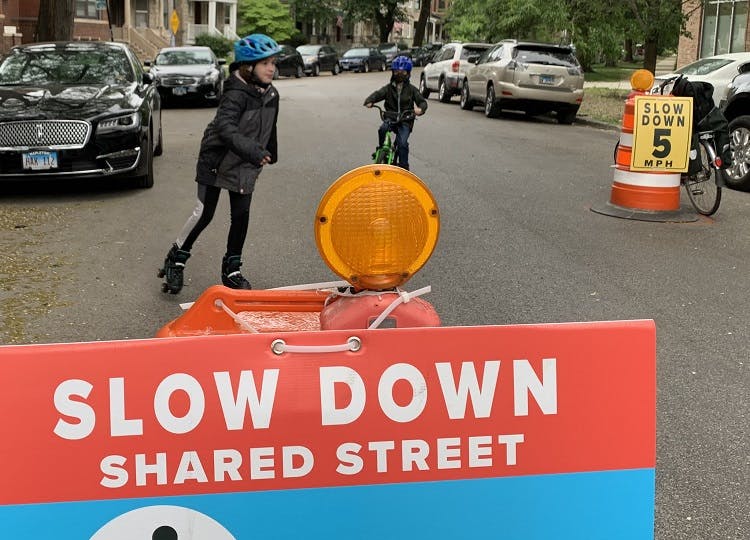Designing Streets for Safety, Not Speed
By: Dave Snyder, senior director for infrastructure

Reducing traffic speeds is one of the most effective strategies to make our streets safer for all road users, not just bicyclists.
Slow streets, like this one in Chicago, help turn dangerous residential streets into child-friendly open spaces. PHOTO CREDIT: City of Chicago
PeopleForBikes’ Legislative Guide for Safe and Connected Bike Infrastructure, a component of our Great Bike Infrastructure Project, is a valuable resource for elected officials and local advocates, showcasing the most effective ways to advance great places to ride through state and local legislation. To help improve bicycling in communities across the U.S., we’ve already explored the how and why behind funding bike infrastructure, mandating Complete Streets, and integrating bikes into climate legislation. In the latest edition of our blog series, we’re reviewing the fourth legislative strategy to create great places to ride — reducing traffic speeds.
Even relatively minor differences in speed can make the difference between life and death. SOURCE: Vision Zero Network
Access Vision Zero Network's resource on preventing unsafe speeds.
While most of the world is reducing traffic danger, injuries and deaths caused by car crashes in the United States continue to increase, injuring millions and killing more than 40,000 people last year alone. One of the big reasons for this ongoing tragedy is the high speeds at which most automobiles travel on U.S. roads. On September 19, PeopleForBikes hosted a webinar with experts from around the country to discuss the importance of reducing traffic speeds to save lives.
WATCH A RECORDING OF THE WEBINAR
Amy Cohen, the director of Families for Safe Streets, a national organization representing the families of victims of traffic violence, shared practical advice on campaigning for significant policy changes. One key example is “Sammy’s Law,” which permits New York City to reduce local speed limits to 20 mph with proper signage. In her presentation, Cohen recounted the moving stories they told and powerful strategies they employed to champion the law which took effect on October 9. She also pointed to the potential of technology, such as intelligent speed assist that alerts drivers who are speeding, and urged support for a California bill that would require the technology in new cars.
The webinar also addressed a common challenge people face when advocating for slower speeds: emergency responders. Charlie Ream, planning and project development team leader at the Oakland Department of Transportation, shared how his agency earned the support of Oakland’s fire and police departments. His successful navigation of the “constant tension between the city and their emergency services departments” resulted in formalized agreements that expedite the installation of certain traffic calming measures that otherwise might be delayed by long negotiations and engineering experiments. You can access those memos, along with his presentation, here.
Christopher Falcos, traffic operations and technology engineer at the Massachusetts Department of Transportation, one of the nation’s leaders in reducing dangerous vehicle speeds, also spoke during the webinar. MDOT’s “Safe Speeds” web page is a model for transportation departments nationwide to prevent serious injuries and fatalities through speed management. As discussed in Falcos’ presentation, one of MDOT’s biggest successes is the integration of speed management in all design decisions, as mandated in the MassDOT Project Development and Design Guide.
Amy Cohen laid out the nation’s failure in stark terms. “We perform abysmally compared to every high-income nation, and it's because other nations are doing everything they can to slow speeds, and we’re not,” she said. "We need every tool in our toolbox.”
To learn more about the best talking points and access resources and policy examples to reduce traffic speeds, check out our resources below:
- Watch the recording of our “Designing Streets for Safety, Not Speed” webinar.
- Review our Legislative Guide for Safe and Connected Bike Infrastructure for examples of states and communities that have lowered speed limits.
- Read our Supplemental Guide for Reducing Traffic Speeds, which includes data-backed talking points to help you advocate for change in your community.
- Learn how reduced traffic speeds increase City Ratings scores.

